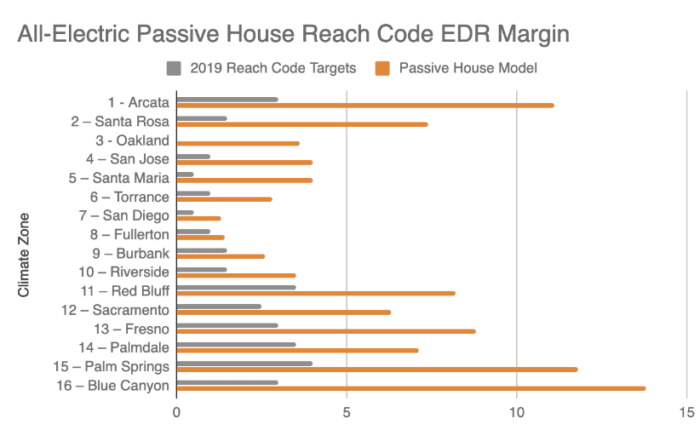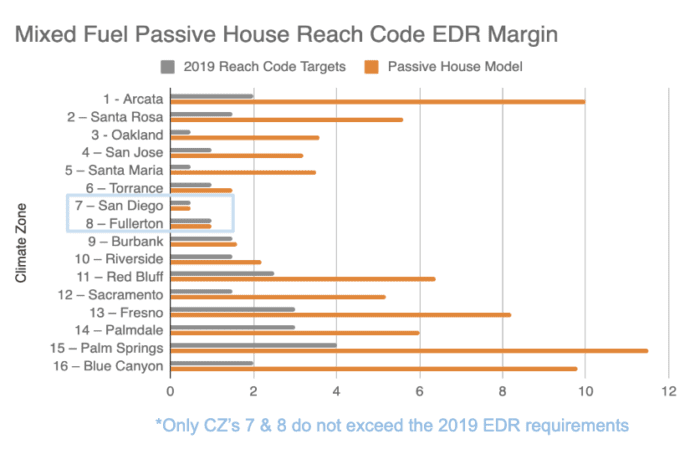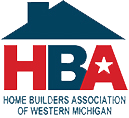
GSW // BUILDING A HIGH PERFORMANCE HOME, IS NOT ALWAYS EXPENSIVE
California’s Codes and Standards (CASE) team issued their review of PHCA’s low-rise multifamily Reach Code proposal last week and the results are remarkable. In today’s blog post we will give you a high level summary so here it is:
- The CASE report confirms Passive House targets deliver performance well beyond that required for reach code Efficiency Design Rating (EDR) margins in all climate zones, (with the exception of the mixed fuel option in CZ’s 7 & 8.) This means that a Passive House multifamily building is also WAY more efficient than a regular code-compliant building, using the upcoming 2019 code requirements. (Which proves what we’ve said previously here that our energy code is still a very low bar…)
- The report confirms that CBECC-Res – the energy model required to calculate Title-24 energy code compliance – is unable to adequately account for many of the features required to meet the Passive House standard (and is likely why Californian design teams have not been utilizing this pathway.) This means that easy performance benefits such as balanced mechanical ventilation coupled with heat recovery, plus air-tightness aren’t being explored here in Cali.
- Passive House Planning Package (PHPP) results were vetted against BEOpt and other energy models for this study. (PHCA members previously confirmed PHPP outputs using the ASHRAE 140 Energy Model Verification Protocol.) PHPP outputs were confirmed to be in alignment with similar energy models, thus providing assurance to policymakers that the PHPP may be approved for use as an alternate compliance tool. (As is already the case in British Columbia, Canada.)
- The North American Passive House Network Policy Resource Guide confirmed that affordable multifamily Passive House buildings in other regions are being built for LESS cost per square foot than similar code-compliant projects. (Yes – you read that correctly! Passive House buildings can be cheaper than code compliant buildings.)

PHCA is now working with California’s cities to encourage them to provide attractive incentives to affordable housing developers who target Passive House low-rise multifamily buildings. Now that CASE has confirmed that these buildings offer far superior performance, there is no reason for cities not to offer great incentives such as increased Floor Area Ratio’s or extra height allowances. We know that adequately trained design professionals can deliver them to the market, but won’t do so until cities or utilities provide some incentive to do so.
Despite the current lack of incentives to aim well above our low baseline code, there are still multiple benefits to developers to taking on this challenge:
- Cost Rationalization: design teams can use the PHPP to provide rationalized cost-benefit analysis to them for ALL building products utilizing the variants tool embedded in the PHPP model. This is how projects in Pennsylvania are being delivered at lower costs than code compliant buildings. (And who doesn’t want accurate analysis to prove that ‘value engineering’ actually does deliver value?)
- Certainty: operating costs for these buildings are verifiable, predictable and can be directly compared against the PHPP energy model. (The CBECC-Res model is a black box model that prevents more granular predicted performance to be verified against actual measured outcomes. There’s no accountability!)
- Affordability: occupants who pay their utility bills will not be vulnerable to energy price spikes. That’s long-term, true affordability!
- Resiliency: these buildings will remain habitable and comfortable as the climate warms. Their design allows these building to remain occupied during power outages caused by either utility blackouts or natural disasters.
Given all the above there is literally NO GOOD REASON NOT TO BUILD PASSIVE HOUSE* low-rise multifamily buildings in every climate here in California. Given today’s climate reality, anything less would be fuelish.


written by Passive House California








